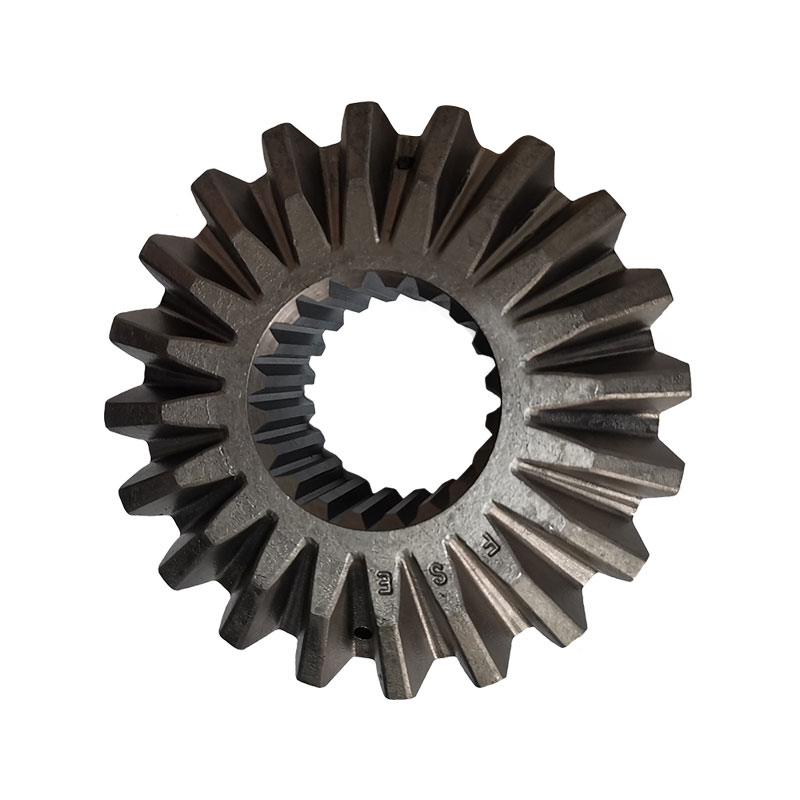1. Fatigue of tooth surface (pitting, flaking) Caus […]
1. Fatigue of tooth surface (pitting, flaking)
Causes and phenomena:
It is mainly due to micro fatigue cracks caused by alternating stress on the working surface. After the lubricant enters the crack, due to the meshing process, the inlet may be closed and then squeezed. The lubricant in the micro fatigue crack expands the crack under high pressure, resulting in small pieces of metal Fall off from the tooth surface, leaving a small pit, forming pitting corrosion. If the fatigue cracks on the surface extend deeper or farther or a series of small pits are connected due to the failure of the material between the pits, causing a large area or a large piece of metal to fall off, this phenomenon is called flaking.
Occurrence location: near the root surface of the pitch line.
Occurrence: closed transmission.
Precautions: increase the hardness of the tooth surface, reduce the surface roughness value, reasonably select the viscosity of the lubricating oil, and adopt the correctness shift gear transmission.
2. Tooth surface wear or scratch
cause:
(1) Adhesive wear.
In the case of low speed, heavy load, high temperature, poor tooth surface roughness, insufficient oil supply, or oil viscosity is too low, the oil film is easily damaged and adhesive wear occurs. The high viscosity of lubricating oil is beneficial to prevent the occurrence of adhesive wear.
(2) Abrasive wear and scratches.
Lubricating oil contains foreign particles and foreign sand particles in the open gear transmission or metal abrasive debris generated in the friction process, can cause abrasive wear and scratches. Generally, the friction of the tooth tip and root is more serious than that of the pitch circle. This is because the pitch circle is in rolling contact during the gear meshing process, while the tooth tip and root are in sliding contact.

(3) Corrosion and wear.
Due to the chemical reaction of some chemical substances such as acid, alkali or water in the lubricating oil and the tooth surface, the metal surface is corroded and the tooth surface is damaged.
(4) Burns.
Burn is the local area overheating caused by excessive friction caused by overload, overspeed or insufficient lubrication. This temperature increase is enough to cause discoloration and over-aging, which will re-quench a few micrometers thick surface layer of steel and appear white layer. Damaged surfaces are prone to fatigue cracks.
Occurrence: open transmission.
Precautions: Use closed transmission to increase the hardness of the tooth surface, reduce contact stress, reduce the surface roughness value, and keep the lubricant clean.
3.Tooth surface glue
cause:
High-power soft tooth surface or high-speed heavy-duty gear transmission, when the lubrication conditions are poor, it is easy to cause tooth surface gluing (bite welding) damage, that is, part of the material on one tooth surface is glued to the other tooth surface on this tooth surface Leaving pits, in the subsequent meshing transmission, the excess material glued on this part can easily cause scratch marks on other tooth surfaces, forming a vicious circle.
Occurrence location: the top surface of the tooth near the pitch line.
Occurrence: high-speed, low-speed heavy-duty gear.
Precautions: suitable lubricating oil, increasing hardness, reducing surface roughness value, and using gear materials with strong anti-gluing ability.
4. Plastic deformation of tooth surface (flash)
cause:
The gears with softer tooth surfaces are frequently started and heavily overloaded. Under the action of excessive friction between the tooth surfaces, the contact stress of the tooth surfaces will exceed the shear strength of the material. The tooth surface materials enter the plastic state, causing the plasticity of the tooth surface metal. The flow makes the tooth surface near the pitch circle of the driving wheel form a concave groove, and the tooth surface near the pitch circle of the driven wheel forms a ridge, thereby destroying the correct tooth shape. Sometimes "flashing" may appear on the driven tooth surface of certain types of gears. In severe cases, the extruded metal fills the head gap, causing violent vibration and even fracture.
Occurrence location: the driving wheel forms a concave groove, and the driven wheel tooth surface forms a convex rib.
Precautions: Improve the hardness of the tooth surface, select a higher viscosity lubricating oil, and avoid frequent starting and severe overload.
5. Broken gear teeth
cause:
Variable load (fatigue, overload), if due to sudden overload or impact overload, it is easy to produce overload fracture at the tooth root. Even if there is no load condition of impact overload, when the gear teeth are repeatedly loaded, due to the stress concentration, fatigue cracks are easy to occur and gradually expand, resulting in fatigue fracture of the gear teeth at the tooth root. In addition, quenching cracks, grinding cracks and excessive wear of tooth thickness after severe wear may cause cracks in any part of the gear teeth. Fracture of the gear teeth is a serious failure of the gear *, which often causes equipment downtime.
Occurrence: Open gear transmission and hard gear closed gear transmission.
Precautions: Choose the appropriate magic and tooth width, use appropriate materials and heat treatment process to reduce the stress concentration at the tooth root.